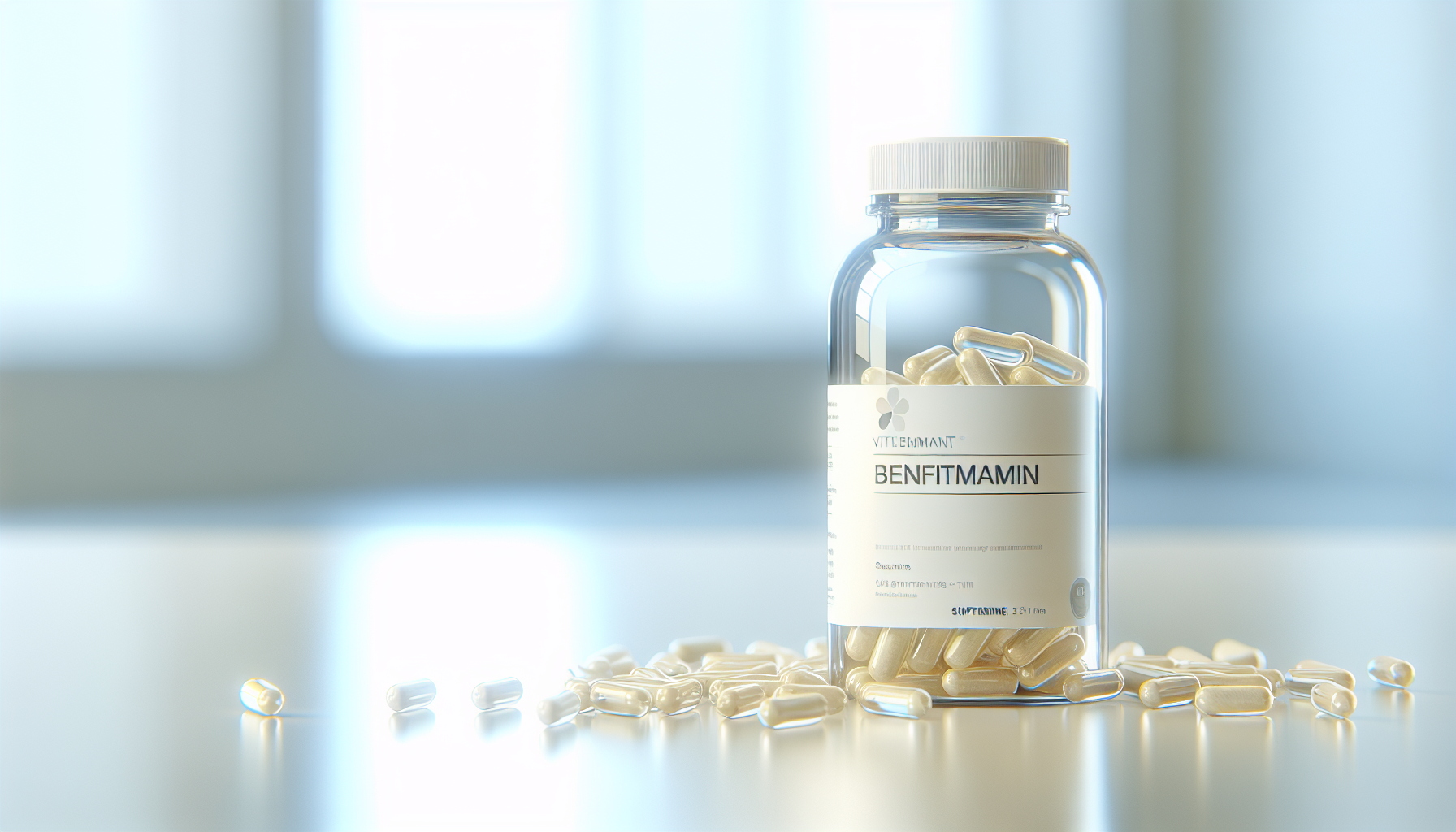Can benfotiamine, a synthetic version of vitamin B1, be the key to reversing neuropathy? In other words, can benfotiamine reverse the neuropathy? This question is of paramount importance for those suffering from various forms of neuropathic pain, such as diabetic neuropathy, peripheral neuropathy, and inflammatory neuropathic conditions. Our article delves into the potential of benfotiamine not just to alleviate discomfort but to potentially reverse nerve damage. Drawing on a wealth of scientific research, including double-blind placebo-controlled trials and studies focused on diabetic polyneuropathy and experimental diabetic retinopathy, we provide a clear, evidence-based perspective on the effectiveness of benfotiamine.
Unlike standard thiamine, benfotiamine is fat-soluble, enhancing its ability to raise blood thiamine levels effectively. This increase in thiamine is crucial for nerve function and could be a significant factor in treating neuropathic pain. Clinical trials have already shown promising results, with benfotiamine providing symptom relief and improving nerve function, particularly in the short term. However, questions remain about the long-term effects and optimal dosage regimens.
Moreover, benfotiamine has demonstrated antioxidative and anti-inflammatory properties, essential in addressing the three major pathways implicated in diabetic complications: the advanced glycation end products, the arachidonic acid pathway, and the polyol pathway. While these findings are encouraging, more research is necessary to conclusively confirm benfotiamine's capability to reverse neuropathy.
Our article aims to be informative and engaging, offering hope without overstating claims. We explore various aspects of benfotiamine treatment, including its role in decreasing oxidative stress, preventing endothelial dysfunction, and its potential to alleviate painful symptoms associated with diabetic neuropathy. We also examine the significance of dietary supplementation with thiamine and benfotiamine in different benfotiamine dosage regimens, considering the effects on nerve pain, muscle weakness, and cognitive decline. Our goal is to provide a comprehensive overview.
Key Takeaways
- Benfotiamine, a fat-soluble version of vitamin B1, is more effective in raising blood thiamine levels, enhancing nerve function, and possibly addressing neuropathic conditions like diabetic neuropathy.
- Clinical trials have shown that benfotiamine can alleviate symptoms and improve nerve function in neuropathy, especially in the short term. However, the long-term effects and ideal dosage regimen are still under study.
- While benfotiamine has been found to have antioxidative and anti-inflammatory properties that could benefit neuropathy patients, further research is needed to determine its ability to reverse neuropathy conclusively.
Understanding Neuropathy and its Underlying Causes

Neuropathy is a term that refers to the damage or dysfunction of one or more nerves, usually resulting in numbness, weakness, or pain in the affected area. One common form is peripheral neuropathy, often resulting from conditions like diabetes, excessive alcohol consumption, or chemotherapy. Such neuropathies can be categorized into mono-neuropathies, multifocal neuropathies, and poly-neuropathies.
Diabetes is one of the leading causes of neuropathy, with high blood glucose levels leading to damage in the small blood vessels responsible for supplying nerves in the body. This impairment ultimately results in diabetic peripheral neuropathy. Thiamine deficiency, a common condition in diabetics, can also contribute to the development of neuropathy.
The role of alcohol in inducing neuropathy is also significant. The combination of direct nerve poisoning by alcohol and the impact of poor nutrition leads to the following:
- Nerve pain
- Tingling or numbness in the extremities
- Muscle weakness
- Difficulty walking or balancing
- Loss of coordination
These symptoms are associated with neuropathy.
Vitamin deficiencies, particularly those of vitamin B12 and B6, can also lead to the development of neuropathy. The role of vitamins in nerve health makes them a crucial factor in neuropathic treatment, as we will explore further with the case of Benfotiamine, a vitamin B1 derivative.
Grasping the root causes of neuropathy paves the way to finding effective treatments, potentially even reversing nerve damage experienced by many neuropathy patients. Could Benfotiamine be part of the answer? Let’s delve into this possibility.
The Role of Benfotiamine in Nerve Function

Benfotiamine, a synthetic derivative of vitamin B1, is believed to aid in addressing nerve damage associated with diabetes and related conditions. As a fat-soluble form of thiamine, Benfotiamine is more effective in increasing blood thiamine levels than regular thiamine, thus enhancing nerve function.
Benfotiamine aids in:
- Restoring mitochondria and producing additional energy for cells
- Enabling the cells to repair their walls and maintain the electrical gradient within the nerve
- Managing painful diabetic neuropathy
- Reducing inflammatory and neuropathic pain through its anti-inflammatory and anti-AGE properties
This therapeutic effectiveness, which prevents experimental diabetic retinopathy, has been observed in managing painful diabetic neuropathy.
Comprehending benfotiamine’s role in nerve function unveils the potential of this supplement in addressing neuropathic pain and possibly reversing diabetic neuropathy. So, let's probe further into these potentials.
Benfotiamine's Impact on Neuropathic Pain
Neuropathic pain results from a lesion or disease affecting the somatosensory system, often stemming from nerve damage. High blood sugar, poorly managed, can contribute to diabetic neuropathy, characterized by sensations of:
- burning
- tingling
- weakness
- pain in the extremities
Treating neuropathic pain often involves medications such as benfotiamine to alleviate these symptoms.
Benfotiamine has been found to mitigate neuropathic pain through its anti-inflammatory properties. It has been shown to:
- Reduce neuropathic pain levels
- Enhance neuropathy scores
- Improve nerve conduction velocity
- Decrease nociception
Significant differences in pain relief have been observed in some placebo-controlled trial studies involving benfotiamine.
Although a 24-month high-dose benfotiamine supplementation did not significantly affect peripheral nerve function, a three-week treatment course improved neuropathic symptoms. Additionally, the Benfotiamine in Diabetic Polyneuropathy (BENDIP) trial, a placebo-controlled clinical trial, indicated significant symptom improvement after a 6-week intervention.
Thus, short-term high-dose benfotiamine treatment seems to show promising results in managing neuropathic pain. However, the long-term effects and different benfotiamine dosage regimens require further exploration, which we will discuss in later sections.
In the interim, it’s worth inspecting the potential of benfotiamine in reversing the effects of diabetic neuropathy.
Potential for Reversing Diabetic Neuropathy
Benfotiamine impacts the progression of diabetic neuropathy by:
- Inhibiting three major pathways involved in high blood sugar damage
- Activating enzymes to redirect excess sugar metabolites
- Reducing the formation of Advanced Glycation End-products (AGEs) by about 40%
- Inhibiting oxidative stress and protein kinase C, both of which contribute to diabetic neuropathy
Benfotiamine positively affects nerve health in diabetic patients by:
- Elevating intracellular thiamine diphosphate levels, a cofactor for the activation of transketolase
- Decreasing tissue levels of AGEs (advanced glycation end products)
- Enhancing cell survival, repair, and apoptosis mechanisms
- Contributing to the enhancement of nerve conduction velocity in diabetic neuropathy patients
- Potentially helping to reverse diabetic neuropathy
Although the potential of benfotiamine in reversing diabetic neuropathy seems promising, it’s worth mentioning that these findings rely on specific clinical trial results. Further research is necessary to confirm benfotiamine’s efficacy in reversing neuropathy.
However, these findings provide hope for those suffering from neuropathy, particularly for those with diabetic neuropathy. Now, we shall shift our focus to the clinical trials that have offered insights into benfotiamine’s potential.
Clinical Insights: Benfotiamine Treatment Trials
Clinical trials on benfotiamine have provided valuable insights into its effectiveness in treating neuropathy. Notable trials, such as the BEDIP Study and the BENDIP trial, have confirmed the efficacy of benfotiamine in treating diabetic polyneuropathy. The BENDIP trial, in particular, revealed substantial improvement in neuropathic symptoms among patients who received benfotiamine treatment.
The findings from double-blind placebo-controlled studies indicate that benfotiamine effectively reduces the neuropathy symptom score, especially at higher doses. It may offer additional treatment possibilities for diabetic polyneuropathy by influencing impaired glucose metabolism. Benfotiamine has also been studied for its potential role in preventing experimental diabetic retinopathy.
Although short-term research suggests that high-dose benfotiamine may improve symptomatic scores in diabetic neuropathy, long-term supplementation has not significantly affected peripheral nerve function. However, some studies have indicated that benfotiamine can improve neuropathy scores, increase nerve conduction velocity, and reduce pain in patients with neuropathy. Benfotiamine has also been shown to prevent experimental diabetic retinopathy in some studies.
In the context of neuropathy treatment trials, benfotiamine has been utilized in both high doses over brief periods and smaller daily dosages, either in conjunction with other treatments or as a standalone therapy. We should probe further into these studies.
Double Blind Placebo Controlled Studies on Benfotiamine
Double-blind placebo-controlled studies have been conducted to assess the efficacy of benfotiamine in treating neuropathy. The results of these studies suggest that benfotiamine can broaden treatment options for patients with diabetic polyneuropathy by positively influencing impaired glucose metabolism. Some of the positive effects of benfotiamine include:
- Reducing pain and numbness in the extremities
- Improving nerve function and conduction
- Increasing blood flow to the nerves
- Decreasing inflammation
These studies have shown the positive effects of benfotiamine, indicating its potential benefits for treating this condition.
The double-blind placebo-controlled studies on benfotiamine for neuropathy included sixty participants and were conducted over periods of up to 12 weeks. These studies provide a firm foundation for understanding the impact of benfotiamine on neuropathy and offer promising data for its use in neuropathic treatment.
Participants in these studies reported no serious adverse events, and benfotiamine was well tolerated. This is a crucial factor to consider when evaluating the potential of benfotiamine as a treatment for neuropathy, as it indicates the supplement’s safety for long-term use.
However, while these studies provide a comprehensive view of the short-term effects of benfotiamine on neuropathy, they do not fully address the long-term effects and different dosage regimens of benfotiamine. So, let's dive deeper into this matter in the following section.
Long-term Effects and Different Benfotiamine Dosage Regimens
In exploring the long-term effects and optimal dosage regimens of benfotiamine for neuropathy treatment, it's crucial to consider the findings from various clinical trials and studies. Although a 24-month benfotiamine supplementation study did not significantly affect peripheral nerve function, shorter-term studies have yielded promising results. Improvements in neuropathy scores, increased nerve conduction velocity, and pain reduction in patients with neuropathy have been observed with benfotiamine intake.
The recommended dosage for treating neuropathy with benfotiamine typically ranges from 150 to 600 mg per day, administered orally for periods of up to six months. This dosage spectrum highlights the importance of personalizing the treatment based on individual responses and specific neuropathic conditions.
When considering the safety of long-term Benfotiamine use, it's valuable to reference insights from the article “Is It Safe to Take Benfotiamine every day? Uncovering Daily Use and Safety.” This article offers an in-depth analysis of the safety profile of daily benfotiamine use. While it generally underscores the safety of benfotiamine, it also sheds light on potential adverse effects such as:
- skin irritation
- allergic reactions
- respiratory difficulties
- facial swelling
- hypotension
- gastrointestinal issues
These side effects, though uncommon, emphasize the need for careful monitoring and consultation with healthcare professionals when using benfotiamine for extended periods. Check out this article here.👇
As we delve deeper into the role of benfotiamine in combating neuropathy, its impact on oxidative stress and inflammation becomes particularly relevant. These factors are critical in the development and progression of neuropathic conditions, and the next section of our article will focus on how benfotiamine addresses these underlying issues.
This comprehensive approach, combining dosage considerations with safety aspects and the mechanism of action, offers a well-rounded perspective for those exploring benfotiamine as a potential treatment for neuropathy.
Addressing Oxidative Stress and Inflammation with Benfotiamine

Oxidative stress plays a significant role in the onset and progression of neuropathy by causing damage to the nervous system, particularly in diabetic neuropathy, and triggering mitochondrial dysfunction. Benfotiamine’s antioxidative properties can address these concerns by exhibiting direct antioxidant effects and potentially enhancing diabetic late complications such as peripheral neuropathy.
In addition to its antioxidative properties, benfotiamine also possesses anti-inflammatory properties that aid in regulating the arachidonic acid pathway in macrophages, thereby contributing to its beneficial effects in treating neuropathy. This dual role of benfotiamine in addressing oxidative stress and inflammation provides another strong argument for its potential in treating neuropathy.
But can it reverse neuropathy? It’s time to tackle this critical question.
Can Benfotiamine Truly Reverse Neuropathy?

The question of whether benfotiamine can truly reverse neuropathy is still under debate. Several studies have presented varied outcomes regarding the impact of benfotiamine on neuropathy reversal. Although some trials indicate its effectiveness in alleviating neuropathic symptoms, additional research is required to conclusively determine its potential in reversing neuropathy.
Research has indicated that benfotiamine may alleviate symptoms and improve nerve function in neuropathy, showing significant benefits in diabetic polyneuropathy and other types of peripheral neuropathy. However, high-dose long-term studies have provided evidence indicating no significant effects on peripheral nerve function.
While the ability of benfotiamine to truly reverse neuropathy is still being investigated, the potential for improvements in peripheral nerve function and nerve repair suggests promising avenues for further research.
Evaluating Improvements in Peripheral Nerve Function
Recent clinical trials suggest that Benfotiamine does not significantly affect peripheral nerve function. Studies have shown no substantial reduction in plasma or urinary AGEs or markers of inflammation and endothelial dysfunction over 12 weeks and even after 24 months of treatment. There were no observed changes in peripheral nerve function or biomarkers of inflammation.
Significant indicators of enhanced peripheral nerve function after Benfotiamine treatment include:
- Improvements in neuropathy scores
- Elevation in nerve conduction velocity
- Decrease in HbA1c levels
- Reduction in pain sensation
Enhancements in peripheral nerve function play a crucial role in reversing neuropathy by promoting nerve regeneration, facilitating synaptic elimination, and stimulating the release of growth factors. Additionally, techniques like exercise following nerve injuries and electrical stimulation have effectively promoted axon regeneration and enhanced functional recovery.
While the evidence for significant improvements in peripheral nerve function with benfotiamine is mixed, its potential for alleviating symptoms and improving nerve function in neuropathy is undeniable.
Assessing the Evidence for Nerve Repair
Benfotiamine promotes nerve repair by enhancing the utilization of thiamine in nerve cells and regulating advanced glycation end products. This is significant as thiamine is vital in nerve health, and advanced glycation end products can potentially contribute to neuropathic damage.
The scientific evidence for nerve repair with benfotiamine includes improvements in neuropathy scores, increases in nerve conduction velocity, and reductions in HbA1c and pain among patients. These findings provide a strong argument for the potential of benfotiamine in nerve repair and neuropathy treatment.
While the evidence for nerve repair with benfotiamine is promising, it is still a matter of ongoing research. The mixed results in various studies indicate the need for further investigation to fully understand the potential of benfotiamine in nerve repair and the reversal of neuropathy.
The Broader Implications of Benfotiamine Supplementation
Beyond its potential benefits for neuropathy, benfotiamine supplementation may also impact other health conditions. Benfotiamine plays a role in preventing diabetic complications by mitigating cardiac dysfunction, tissue damage, and other potentially serious complications.
Regarding heart health, benfotiamine supplementation offers potential advantages, such as preventing diabetes-induced diastolic dysfunction and heart failure. Additionally, benfotiamine has shown potential in mitigating antibiotic-induced nephrotoxicity and safeguarding the peritoneal membrane and remnant kidney, shedding light on its potential benefits for kidney function.
There is also the possibility that benfotiamine supplementation could improve vision and promote eye health. These broader implications of benfotiamine supplementation highlight its potential benefits beyond neuropathy treatment, making it an important supplement for overall health and well-being.
Personal Stories: Living with Neuropathy Before and After Benfotiamine
Personal stories from individuals living with neuropathy before and after benfotiamine treatment provide a unique perspective on the impact of this supplement. Before commencing Benfotiamine treatment, individuals with neuropathy reported experiencing:
- Aching
- Burning
- Tingling sensations in their feet
- Lack of electrical impulses
After treatment, many individuals reported significantly reducing these symptoms and improved overall quality of life.
Personal experiences serve as evidence of the positive effects of Benfotiamine on neuropathy symptoms, such as pain relief in individuals with diabetic neuropathy. These stories provide a glimpse into the real-life impact of Benfotiamine on neuropathy and offer hope to those currently struggling with this condition.
Anecdotal evidence and short-term clinical studies indicate that Benfotiamine promotes nerve health and supports healthy aging. However, these sources suggest that high-dose supplementation may not substantially affect peripheral nerve function.
Despite this, the personal stories shared by individuals who have experienced improvements in their neuropathy symptoms after taking benfotiamine provide a testament to the potential benefits of this supplement. While scientific research is essential, these personal accounts offer a unique perspective on the impact of benfotiamine on individuals living with neuropathy.
Benfotiamine Explored: Summarizing Our Deep Dive into Neuropathy Treatment
In our in-depth exploration of benfotiamine, a synthetic derivative of vitamin B1, we've ventured deeper into the realms of medical science than usual, aiming to provide a comprehensive understanding of its role in potentially managing and reversing neuropathy. While we've delved into more complex scientific details, our goal has been to make this intricate topic accessible and engaging. Benfotiamine's ability to enhance nerve function and its potential to combat oxidative stress and inflammation paints a promising picture for those struggling with neuropathic conditions. Through various clinical trials and personal accounts, we've uncovered a tapestry of hope and possibility that benfotiamine presents for neuropathy sufferers.
We understand that the depth of information might seem overwhelming, but it's crucial for a condition as complex as neuropathy. The stories of individuals who have experienced life before and after benfotiamine treatment bring a personal touch to our discussion, bridging the gap between scientific theory and real-world experiences. Moreover, exploring benfotiamine's broader health implications, including its potential benefits for heart health, kidney function, and vision, highlights its significance beyond neuropathy treatment. This aligns with our commitment to providing well-rounded, insightful content that empowers our readers in their health journeys.
Lastly, for those interested in integrating benfotiamine into their wellness routines, we invite you to read our review article (linked below), “Why Benfotiamine Supplements Could be the Best-Kept Secret in Health Nutrition.” This piece offers a curated look at the top five benfotiamine supplements available in the market, providing you with reliable options to consider. We hope this article and our comprehensive exploration of benfotiamine leaves you feeling informed, inspired, and ready to make well-considered decisions for your health and well-being.👇
Frequently Asked Questions
How long does it take for benfotiamine to start working?
You may start experiencing therapeutic benefits from benfotiamine as early as 3 weeks, with the most significant improvements occurring at 6 weeks when taking the highest dose of 600 mg/day.
Can nerve damage from neuropathy be reversed?
Peripheral neuropathy cannot be cured, but taking steps to address underlying conditions like diabetes can help prevent it from worsening, and treating the associated pain and symptoms can improve quality of life.
What is neuropathy, and what causes it?
Neuropathy is damage or dysfunction of a nerve, often caused by conditions such as diabetes, excessive alcohol consumption, or chemotherapy. These conditions can lead to nerve damage, resulting in neuropathy.
What are the broader implications of benfotiamine supplementation?
Benfotiamine supplementation has broader implications for heart health, kidney function, and vision and may help prevent diabetic complications. It offers potential benefits beyond just neuropathy.
What are the experiences of individuals living with neuropathy before and after benfotiamine treatment?
Many individuals with neuropathy have reported improvement in aching, burning, and tingling sensations in their feet after taking benfotiamine. However, high-dose supplementation may not have substantial effects on peripheral nerve function.
Thanks for taking this journey to explore Benfotiamine and its potential impact on neuropathies. Also, if you want to add to your library of knowledge, you should check out the other articles mentioned and linked above. It never hurts to add to your knowledge arsenal!
Please return soon to check out our next review of another incredible supplement – we’re always looking out for YOU!
*We are not qualified medical advisors. The content here is only based on our personal opinions and should NOT be used as a substitute for a healthcare professional's advice!











Member discussion